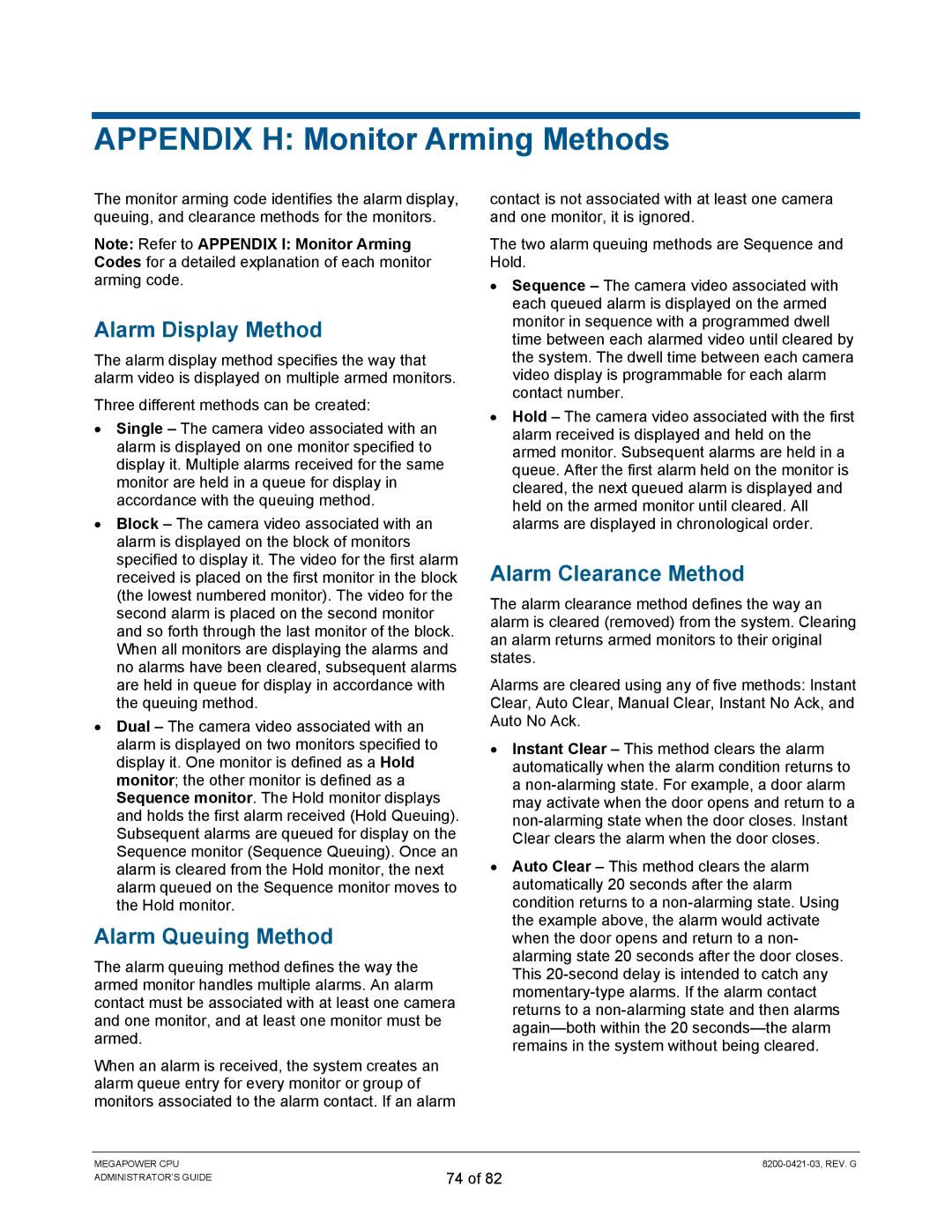
APPENDIX H: Monitor Arming Methods
The monitor arming code identifies the alarm display, queuing, and clearance methods for the monitors.
Note: Refer to APPENDIX I: Monitor Arming Codes for a detailed explanation of each monitor arming code.
Alarm Display Method
The alarm display method specifies the way that alarm video is displayed on multiple armed monitors.
Three different methods can be created:
•Single – The camera video associated with an alarm is displayed on one monitor specified to display it. Multiple alarms received for the same monitor are held in a queue for display in accordance with the queuing method.
•Block – The camera video associated with an alarm is displayed on the block of monitors specified to display it. The video for the first alarm received is placed on the first monitor in the block (the lowest numbered monitor). The video for the second alarm is placed on the second monitor and so forth through the last monitor of the block. When all monitors are displaying the alarms and no alarms have been cleared, subsequent alarms are held in queue for display in accordance with the queuing method.
•Dual – The camera video associated with an alarm is displayed on two monitors specified to display it. One monitor is defined as a Hold monitor; the other monitor is defined as a Sequence monitor. The Hold monitor displays and holds the first alarm received (Hold Queuing). Subsequent alarms are queued for display on the Sequence monitor (Sequence Queuing). Once an alarm is cleared from the Hold monitor, the next alarm queued on the Sequence monitor moves to the Hold monitor.
Alarm Queuing Method
The alarm queuing method defines the way the armed monitor handles multiple alarms. An alarm contact must be associated with at least one camera and one monitor, and at least one monitor must be armed.
When an alarm is received, the system creates an alarm queue entry for every monitor or group of monitors associated to the alarm contact. If an alarm
contact is not associated with at least one camera and one monitor, it is ignored.
The two alarm queuing methods are Sequence and Hold.
•Sequence – The camera video associated with each queued alarm is displayed on the armed monitor in sequence with a programmed dwell time between each alarmed video until cleared by the system. The dwell time between each camera video display is programmable for each alarm contact number.
•Hold – The camera video associated with the first alarm received is displayed and held on the armed monitor. Subsequent alarms are held in a queue. After the first alarm held on the monitor is cleared, the next queued alarm is displayed and held on the armed monitor until cleared. All alarms are displayed in chronological order.
Alarm Clearance Method
The alarm clearance method defines the way an alarm is cleared (removed) from the system. Clearing an alarm returns armed monitors to their original states.
Alarms are cleared using any of five methods: Instant Clear, Auto Clear, Manual Clear, Instant No Ack, and Auto No Ack.
•Instant Clear – This method clears the alarm automatically when the alarm condition returns to a
•Auto Clear – This method clears the alarm automatically 20 seconds after the alarm condition returns to a
MEGAPOWER CPU ADMINISTRATOR’S GUIDE
74 of 82
